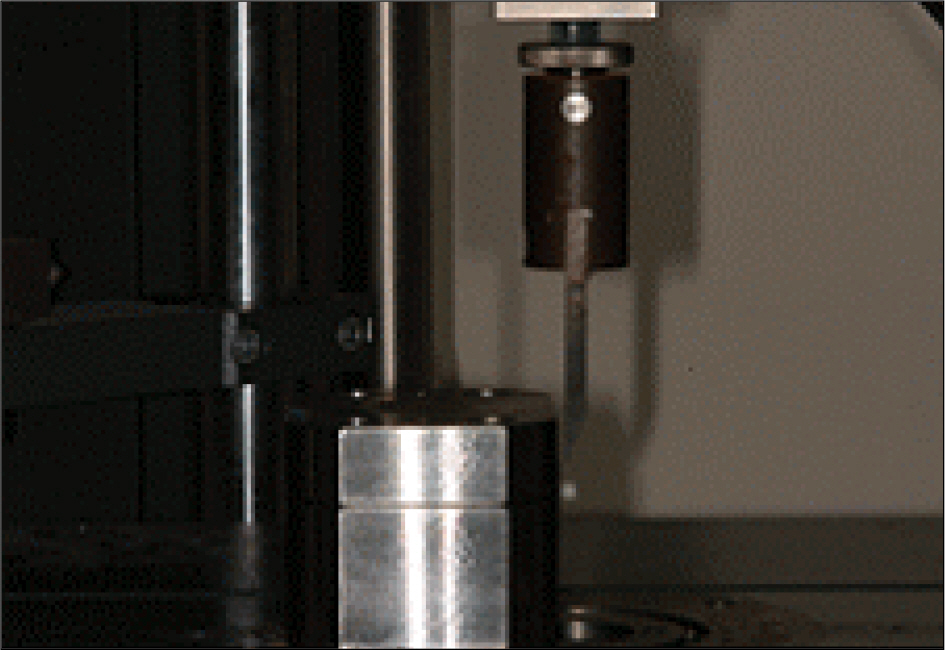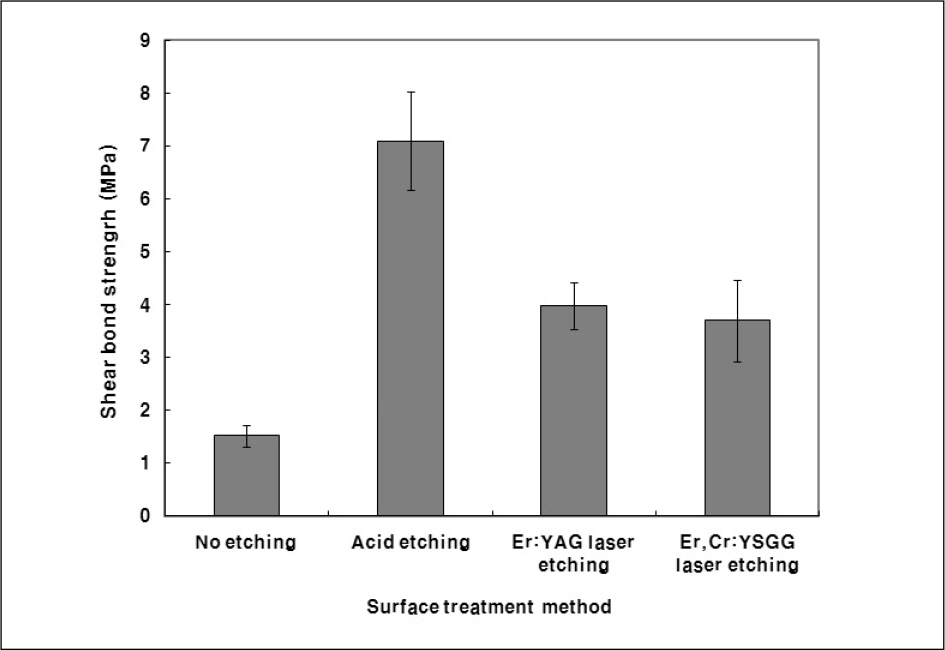J Korean Acad Prosthodont.
2008 Oct;46(5):520-527. 10.4047/jkap.2008.46.5.520.
Effects of laser-irradiated dentin on shear bond strength of composite resin
- Affiliations
-
- 1Department of Dentistry, Graduate School, Wonkwang University, Korea. hwcho@wonkwang.ac.kr
- KMID: 2000409
- DOI: http://doi.org/10.4047/jkap.2008.46.5.520
Abstract
- PURPOSE
This study was conducted to evaluate the shear bond strength of composite resin to dentin when etched with laser instead of phosphoric acid. MATERIAL AND METHODS: Recently extracted forty molars, completely free of dental caries, were embedded into acrylic resin. After exposing dentin with diamond saw, teeth surface were polished with a series of SiC paper. The teeth were divided into four groups composed of 10 specimens each; 1) no surface treated group as a control 2) acid-etched with 35 percent-phosphoric acid 3) Er:YAG laser treated 4) Er,Cr:YSGG laser treated. A dentin bonding agent (Adapter Single Bond2, 3M/ESPE) was applied to the specimens and then transparent plastic tubes (3 mm of height and diameter) were placed on each dentin. The composite resin was inserted into the tubes and cured. All the specimens were stored in distilled water at 37degree C for 24 hours and the shear bond strength was measured using a universal testing machine (Z020, Zwick, Germany). The data of tensile bond strength were statistically analyzed by one-way ANOVA and Duncan's test at alpha = 0.05. RESULTS: The bond strengths of Er:YAG laser-treated group was 3.98 +/- 0.88 MPa and Er,Cr:YSGG laser-treated group showed 3.70 +/- 1.55 MPa. There were no significant differences between two laser groups. The control group showed the lowest bond strength, 1.52 +/- 0.42 MPa and the highest shear bond strength was presented in acid-etched group, 7.10 +/- 1.86 MPa (P < .05). CONCLUSION: Laser- etched group exhibited significantly higer bond strength than that of control group, while still weaker than that of the phosphoric acid-etched group.
Keyword
MeSH Terms
Figure
Reference
-
1.Moritz AF., Beer F., Goharkhay K., Schoop U., Strassl M. Oral Laser Application. Quintessence Publishing Co. Inc;2006.2.Goldman L., Hornby P., Meyer R., Goldman B. Impact of the laser on the dental caries. Nature. 1964. 203:417.3.Miserendino LJ., Pick RM. Lasers in dentistry-Clinical application of the Nd: YAG laser. Quintessence Publishing Co. Inc;p. 199–216. 1995.4.Tafomori S., Iwase T. Ultrastructural change of enamel exposed to a normal pulsed Nd: YAG laser. Caries Res. 1995. 29:513–20.5.Yamamoto H., Sato K. Prevention of dental caries by acousto-optically Q-switched Nd: YAG laser irradiation. J Dent Res. 1980. 59:137.6.Lobene RR., Fine S. Interaction of laser radiation with oral hard tissues. J Prosthet Dent. 1966. 16:589–97.
Article7.Cox CJ., Pearson GJ., Palmer G. Preliminary in vitro investigation of the effects of pulsed Nd: YAG laser radiation on enamel and dentine. Biomaterials. 1994. 15:1145–51.8.Pogrel MA., Muff DF., Marshall GW. Structural changes in dental enamel induced by high energy continuous wave carbon dioxide laser. Lasers Surg Med. 1993. 13:89–96.
Article9.McCormack SM., Fried D., Featherstone JD., Glena RE., Seka W. Scanning electron microscope observations of CO₂laser effects on dental enamel. J Dent Res. 1995. 74:1702–8.10.Palamara J., Phakey PP., Orams HJ., Rachinger WA. The effect on the ultrastructure of dental enamel of excimer-dye, argon-ion and CO₂lasers. Scanning Microsc. 1992. 6:1061–71.11.Wigdor H., Abt E. Ashrafi S, Walsh JT Jr. The effects of lasers on dental hard tissues. J Am Dent Assoc. 1993. 124:65–70.12.Eversole LR. Rizoiu I, Kimmel AI. Pulpal response to cavity preparation by an erbium, chromium: YSGG laser-powered hydrokinetic system. J Am Dent Assoc. 1997. 128:1099–106.13.Liberman R., Segal TH., Nordenberg D., Serebro LI. Adhesion of composite materials to enamel: comparison between the use of acid and lasing as pretreatment. Lasers Surg Med. 1984. 4:323–7.
Article14.Cooper LF., Myers ML., Nelson DG., Mowery AS. Shear strength of composite bonded to laser-pretreated dentin. J Prosthet Dent. 1988. 60:45–9.
Article15.Visuri SR. Gilbert JL. Wright DD. Wigdor HA, Walsh JT Jr. Shear strength of composite bonded to Er: YAG laser-prepared dentin. J Dent Res. 1996. 75:599–605.16.Moritz A., Schoop U., Goharkhay K., Szakacs S., Sperr W., Schweidler E., Wernisch J., Gutknecht N. Procedures for enamel and dentin conditioning: a comparison of conventional and innovation methods. J Esthet Dent. 1998. 10:84–93.17.Keller U., Hibst R. Experimental studies of the application of the Er: YAG laser on dental hard substances: II. Light microscopic and SEM investigation. Lasers Surg Med. 1989. 9:345–51.18.Kataumi M., Nakajima M., Yamada T., Tagami J. Tensile bond strength and SEM evaluation of Er: YAG laser irradiated dentin using dentin adhesive. Dent Mater J. 1998. 17:135–8.19.Armengol V., Jean A., Marion D. Temperature rise during Er: YAG and Nd: YAG laser ablation of dentin. J Endod. 2000. 26:138–41.20.Kameyana A., Oda Y., Hirai Y., Kawada E., Takizawa M. Resin bonding to Er: YAGlaser-irradiated dentin: combined effects of pretreatment with citric acid and glutaraldehyde. Eur J Oral Sci. 2001. 109:354–60.21.Ishioka S., Caputo AA. Interaction between the dentinal smear layer and composite bond strengths. J Prosthet Dent. 1989. 61:180–5.22.Gwinnett AJ. Quantitative contribution of resin infiltration/hybridization to dentin bonding. Am J Dent. 1993. 6:7–9.23.Eick JD. Smear layer-materials surface. Proc Finn Dent Soc. 1992. 88:225–42.24.Nakabayashi N., Takarada K. Effect of HEMA on bonding to dentin. Dent Mater. 1992. 8:125–30.
Article25.van Meerbeek B., Inokoshi S., Braem M., Lambrechts P., Vanherle G. Morphological aspects of the resin-dentin interdiffusion zone with different dentin adhesive systems. 1992. 71:1530–40.26.Aoki A., Ishikawa I., Yamada T., Otsuki M., Watanabe H., Tagami J., Ando Y., Yamamoto H. Comparison between Er: YAG laser and conventiona l caries treatment in vitro. J Dent Res. 1998. 77:1404–14.27.Ceballos L., Osorio R., Toledano M., Marshall GW. Microleakage of composite restorations after acid or ErYAG laser cavity treatments. Dent Mater. 2001. 17:340–6.
Article28.Vargas MA., Cobb DS., Denehy GE. Interfacial micromorphology and shear bond strength of single-bottle primer/adhesives. Dent Mater. 1997. 13:316–24.
Article29.Arimoto N., Suauki A., Sakuma K., Kashiraha S., Yamada M., Senda A. Microstructural changes in dentin irradiated by Er: YAG laser. J Dent Res. 1999. 78:318.30.Harima T., Fujitani M., Fujita H., Murakami A., Ohshima K., Shintani H. Adhesive propertisinous materials to laserd dentin: part 3 Treatment for structural defects and heat-de-natulaced layer. Jpn J Conserv Dent. 1999. 42:78–8.31.Nakabayashi N., Sami Y. Bonding of intact dentin. J Dent Res. 1996. 75:1706–15.32.De Munck J., van meerbeek B., Yudhira R., Lambrechts P., Vanherle G. Micro-tensile bond strength of two adhesives to Erbium: YAG lased vs. bur-cut enamel and dentin. Eur J Oral Sci. 2002. 110:322–9.33.Benazzato P., Stefani A. The effect of Er: YAG laser treatment on dentin collagen: An SEM investigation. J Oral Laser Appl. 2003. 3:79–81.
- Full Text Links
- Actions
-
Cited
- CITED
-
- Close
- Share
- Similar articles
-
- The effect of Er,Cr:YSGG irradiation on microtensile bond strength of composite resin restoration
- Shear bond strength of a self-adhesive resin cement to resin-coated dentin
- Effect of pre-heating on some physical properties of composite resin
- The effect of repeated bonding on the shear bond strength of different resin cements to enamel and dentin
- In vitro micro-shear bond strength of five composite resins to dentin with five different dentin adhesives






